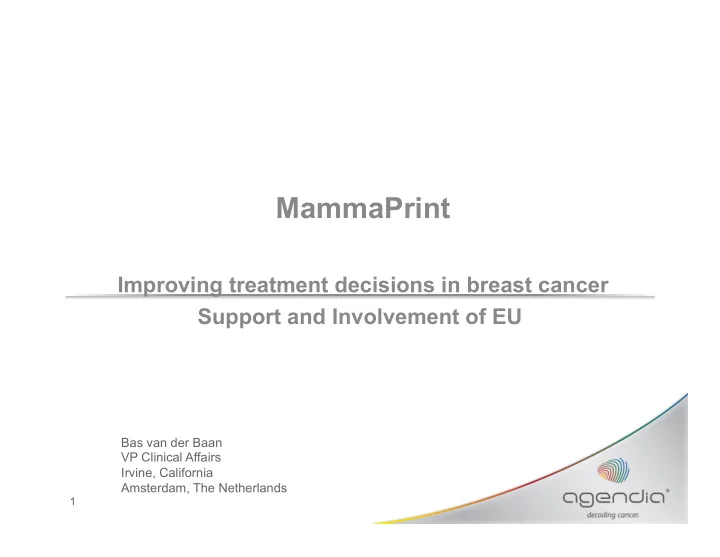

MammaPrint Improving treatment decisions in breast cancer Support and Involvement of EU Bas van der Baan VP Clinical Affairs Irvine, California Amsterdam, The Netherlands 1
2
Two Crucial Questions in Cancer Who needs additional Which therapy is most therapy after effective surgery? Prognosis Prediction 3 ¡
Recurrences and Mortality: >50 y
With an average 4% reduction in recurrence and 3% reduction in mortality in patients over age 50 … How can we identify patients who will benefit from adjuvant treatment?
MammaPrint developed using unbiased gene selection based on patient outcomes LOW Full ¡human ¡ RISK genome ¡ No ¡distant ¡ 25K ¡ ¡ metastasis ¡ within ¡5 ¡years ¡ ¡ “Untreated” ¡ tumor ¡samples ¡ Ranking ¡ ¡ with ¡up ¡to ¡20 ¡year ¡ follow-‑up ¡ ¡ ¡ 70 ¡most ¡significant ¡genes ¡ predic:ve ¡of ¡recurrence ¡ risk ¡were ¡iden:fied ¡ Full ¡human ¡ genome ¡ ¡ Distant ¡ 25K ¡ metastasis ¡ within ¡5 ¡years ¡ ¡ HIGH RISK
First to prove clinical utility Nature Paper: The Breakthrough 78 Patients 70 Genes Van ‘t Veer et al, Gene expression profiling predicts clinical outcome of breast cancer , Nature, Vol 415, 2002
Clinical Validity NEJM 2002 8
Levels of evidence determination Category A prospective, randomized clinical trial designs Category B prospective studies using archived tissue samples Category C prospective, observational registry studies Level I 1 study from Cat A or ≥ 1 studies from Cat B Level II 1 study from Cat B or ≥ 2 studies from Cat C Level III 1 study from Cat C Levels Simon JNCI 2009 10
Category A: Clinical Utility A Prospect Randomized Controlled Trial Against Standard of Care 11
MINDACT Trial Design (n = 6,694); REGISTRATION Clinical-pathological Clinical-pathological Discordant cases and MammaPrint and MammaPrint n = 2,142 both LOW risk both HIGH risk n = 2,743 n = 1,807 Clin-Path HIGH Clin-Path LOW MammaPrint LOW MammaPrint HIGH RANDOMIZE Use Clin-Path risk to Use MammaPrint risk to determine Chemo use determine Chemo use Chemotherapy Endocrine therapy Endocrine therapy
Influence health outcome Discordance between Clinical Risk assessment and MammaPrint in MINDACT N = 6694 3358 ¡(50%) ¡ 2401 ¡(36%) ¡ 957 pt more low risk 592 MammaPrint 1550 MammaPrint High / Clinical Low Low / Clinical High 3336 ¡(50%) ¡ 4293 ¡(64%) ¡ Adjuvant! ¡ MammaPrint ¡ Clinical Risk 32% Discordance between MammaPrint and Clinical risk assessment 13 ¡ Rutgers et al ESMO 2013
Category C: Clinical Utility 14
MammaPrint High Risk Patients had a Relatively Good 5 Year Distant Recurrence Free Interval 5YR DDFS 208 ¡(49%) ¡ 91.2% 81% adjuvant chemotherapy 97% 219 ¡(51%) ¡ 132 ¡(31%) ¡ 85% no adjuvant chemotherapy ¡ MammaPrint
MammaPrint Analytical and Clinical Validity Externally confirmed in 6 FDA clearances Clearance ¡ ¡ Year ¡ Clearance ¡ ¡ MammaPrint ¡in ¡Formalin ¡Fixed ¡Paraffin ¡ 2015 ¡ K141142 ¡ Embedded ¡Tissue ¡ MammaPrint ¡in ¡all ¡Agendia ¡controlled ¡ 2011 ¡ K101454 ¡ ¡ Laboratories ¡ MammaPrint ¡in ¡post ¡menopausal ¡women ¡ 2009 ¡ K81092 ¡ ¡ Use ¡of ¡High ¡Density ¡Microarray ¡Chip ¡ 2008 ¡ K08252 ¡ ¡ MammaPrint ¡Ambient ¡Temperature ¡ 2007 ¡ K70675 ¡ ¡ MammaPrint ¡Fresh ¡Frozen ¡ 2007 ¡ K062694 ¡ ¡ 2007 DE Novo 510K MammaPrint is the predicate devices for future multi gene assays for breast cancer prognosis FDA clearances 16
Feedback National Institute Clinical Excellence UK • The Committee considered that the uncertainty in the clinical-effectiveness evidence for MammaPrint limited the validity of the economic analysis. 17
Clinical Utility • Test influences treatment decision: impact • Test improves health outcome – Improved survival – Less toxicity and cost without compromising outcome 18
Why H2020 • Limited reimbursement in Europe leads to limited clinical adoption, leads to over utilization of chemotherapy – New type of test – New levels of evidence required – Impact different in different EU countries – Returns in diagnostics can not justify the clinical trials necessary, it is not a drug 19
H2020 Project proposal • Establish robust data on Clinical Utility – Retrospective analysis of a Prospective Randomized Trail for Prognosis – Retrospective analysis of a Prospective Randomized Trail for Therapy Benefit • Establish impact data – Prospective PRIME trial Germany 20
Why successful? • Extensive detailed feedback from reimbursement authorities on the limitations • Concrete plan to overcome the limitations • Clear path to clinical adoption after completion of the project • Clear path for growth after completion • Clear benefit for EU breast cancer patients – Up to 70% of patients can safely forego chemotherapy 21
Recommend
More recommend